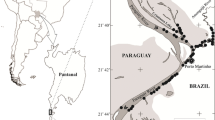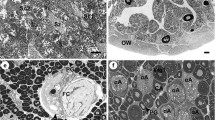Abstract
To evaluate the spawning success of male Japanese minnows,Pseudorasbora parva, and female mate choice, spawning behaviour was observed under both artificial and experimental conditions. Larger males had larger territories and greater reproductive success. The body weight of territorial males decreased during the maintenance of territories, while that of non-territorial males increased significantly. When the weight of non-territorial males exceeded that of territorial males, the former began to establish new territories on the substrate, suggesting a conditional strategy by non-territorial males to trade off immediate reproductive success with growth and hence improve future reproductive success. Females chose males with larger body size, probably based on dominance rank rather than the quality (or size) of territory. It was concluded that females choose males of higher dominance rank and that males compete for large territories, both of which play an important part in male reproductive success.
Similar content being viewed by others
Literature Cited
Banarescu, P. and T. T. Nalbant. 1973. Pisces, Teleostei. Water de Gruyter, Berlin. 304 pp.
Bateson, P. 1983. Mate choice. Cambridge University Press, Cambridge. 462 pp.
Berglund, A., G. Rosenqvist and I. Svensson. 1986. Mate choice, fecundity and sexual dimorphism in two pipefish species (Syngnathidae). Behav. Ecol. Sociobiol., 19: 301–307.
Bisazza, A. and A. Marconato. 1988. Female mate choice, male-male competition and parental care in the river bullhead,Cottus gobio L (Pisces, Cottidae). Anim. Behav., 36: 1352–1360.
Bisazza, A., A. Marconato and G. Marin. 1989. Male competition and female choice inPadogobius martensi (Pisces: Gobiidae). Anim. Behav., 38: 406–413.
Brown, L. 1981. Patterns of female choice in mottled sculpin (Cottidae, Teleostei). Anim. Behav., 29: 373–382.
Coleman, R. N., M. R. Gross and R. C. Sargent. 1985. Parental investment decision rules: a test in the bluegill sunfish. Behav. Ecol. Sociobiol., 18: 59–66.
Constanz, G. D. 1975. Behavioral ecology of mating in the male Gila topminnow,Poeciliopsis occidentalis (Cyprinodontiforms: Poeciliidae). Ecology, 56:966–973.
Coté, I. M. and W. Hunte. 1989. Male and female mate choice in the redlip blenny: why bigger is better. Anim. Behav., 38: 78–88.
DeMartini, E. E. 1987. Parental defence, cannibalism and polygamy: factors influencing the reproductive success of painted greenling (Pisces, Hexagrammidae). Anim. Behav., 35: 1145–1158.
Deutsch, C. J., M. P. Haley and B. J. LeBoeuf. 1990. Reproductive effort of male elephant seals: estimates from mass loss. Can. J. Zool., 68: 2580–2593.
Downhower, J. F. and L. Brown. 1980. Mate preferences of female mottled sculpins.Cottus bairdi. Anim. Behav., 28: 728–734.
Gross, M. R. and R. C. Sargent. 1985. The evolution of male and female parental care in fishes. Am. Zool., 25: 775–793.
Hastings, P. A. 1988. Female choice and male reproductive success in the angel blenny,Coralliozetus angelica (Teleostei: Chaenopside). Anim. Behav., 36: 115–124.
Hoelzer, G. A. 1990. Male-male competition and female choice in the Cortez damselfish,Stegastes rectifraenum. Anim. Behav., 40: 339–349.
Huntingford, F. 1984. The study of animal behaviour. Chapman and Hall, London. 411 pp.
Jones, G. P. 1981. Spawning-site choice by femalePseudolasborus celidotus (Pisces, Labridae) and its influence on mating system. Behav. Ecol. Sociobiol., 8: 129–142.
Katano, O. 1985. Aggressive behaviour and dominance relationships of the dark chubZacco temmincki with special reference to their individual recognition. Japan. J. Ichthyol., 32: 225–238.
Katano, O. 1990. Dinamic relationships between the dominance of male dark chubZacco temmincki, and their acquisition of females. Anim. Behav., 40: 1018–1034.
Katano, O. 1993. Factors affecting mating status of the male dark chubZacco temmincki. Phisiol. Ecol. Japan, 29: 118–131.
Katano, O. and K. Maekawa. In press. Reproductive regulation in the female Japanese minnow (Cyprinidae). Env. Biol. Fish.
Kawanabe, H. and N. Mizuno (eds.). 1990. Freshwater fishes in Japan. Yamatokeikousha, Tokyo. 719 pp. (In Japanese).
Martel, G. and J. M. Green. 1987. Differential spawning success among territorial male cunners,Tautogolabrus adspersus (Labridae). Copeia, 1987: 643–648.
Mathis, A. 1991. Large male advantage for access to females: evidence of male-male competition and female discrimination in a territorial salamander. Behav. Ecol. Sociobiol., 29: 133–138.
Mori, S. 1993. The breeding system of the threespined sticklebackGasterosteus aculeatus (forma leiura) with reference to spatial and temporal patterns of nesting activity. Behav., 126: 97–124.
Nakamura, M. 1969. Cyprinid fishes of Japan—studies on the life history of cyprinid fishes of Japan. Research Institute for Natural Resources, Tokyo. 455 pp. (In Japanese).
Nichols, J. T. 1929. Some Chinese freshwater fishes. Am. Mus. Novitates, (377): 1–11
Noonan, K. C. 1983. Female mate choice in the cichlid fishCichlasoma nigrifasciatum. Anim. Behav., 31: 1005–1010.
Perrone, M. 1978. Mate size and breeding success in a monogamous cichlid fish. Env. Biol. Fish., 3: 193–201.
Sargent, R. C. and M. R. Gross. 1986. William's principle: an explanation of parental care in teleost fishes. Pages 275–293in T. J. Pitcher, ed. The behaviour of teleost fishes. Croom Helm, London.
Schmale, M. C. 1981. Sexual selection and reproductive success in males of the bicolor damselfish,Eupomacentrus partitus (Pisces: Pomacentridae). Anim. Behav., 29: 1172–1184.
Taborsky, M. 1994. Sneakers, satellites and helpers: parasitic and cooperative behavior in fish reproduction. Adv. Study Behav., 23: 1–100.
Thompson, S. 1986. Male spawning success and female choice in the mottled triplefin,Forsterygion varium (Pisces: Tripterygiidae). Anim. Behav., 34: 580–589.
van den Berghe, E. P. 1992. Parental care and the cost of reproduction in a Mediterranean fish. Behav. Ecol. Sociobiol., 30: 373–378.
Wootton, R. J. 1990. Ecology of teleost fishes. Chapman & Hall, London. 404 pp.
Yabe, H. 1942. Breeding habits of a small cyprinoid fish,Pseudorasbora parva Temminck & Schlegel in the paddy-field. Plants Anim., 5: 1860–1864. (In Japanese.).
Author information
Authors and Affiliations
About this article
Cite this article
Maekawa, K., Iguchi, K. & Katano, O. Reproductive success in male Japanese minnows,Pseudorasbora parva: observations under experimental conditions. Ichthyological Research 43, 257–266 (1996). https://doi.org/10.1007/BF02347598
Received:
Revised:
Accepted:
Issue Date:
DOI: https://doi.org/10.1007/BF02347598




